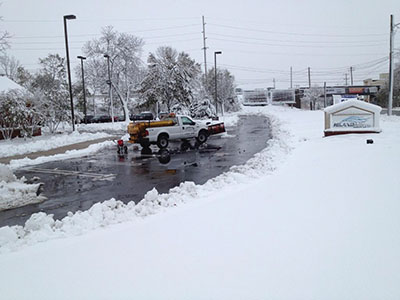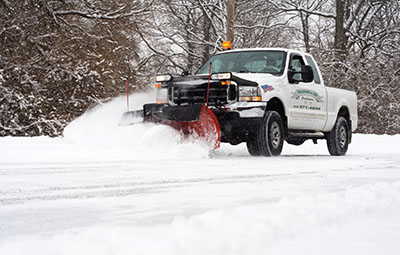What is your snow removal backup plan?
You have selected your service partner(s) to manage your snow removal services for the upcoming snow season. You are hopefully fully immersed in the transition process and local crews are being lined up. Now sit back and think about this: What if you chose the wrong vendor?
Not what you wanted to hear? Unfortunately, for anyone who has been in this business for a while, this is a very real question and often becomes a reality. Yes, their pricing seemed good — like really good! Plus, they said they understood your scope of work and what your expectations are. How could they not deliver as expected?
Unfortunately, snow removal is no different than any other trade service. The marketplace is sometimes very crowded, and seeing the proverbial forest through the trees is not always easy. While even the best of vendors can sometimes stumble, what does that mean for those providers who are at the bottom half of the vendor pool? And 50% of all vendors who call you are in the bottom half.
Changing vendors is enormously commonplace for retailers. But why? While ‘price’ is king is today’s market, ‘service’ is what keeps your stores open. Unfortunately, learning during a major snow event that your vendor is not as prepared or capable of delivering promised services could have a crushing impact. Credibility is in question with with store operations; lost business; and the internal repercussions of delivering a program that failed to achieve its own goals.
That’s the scary news. More importantly, what can be done to prevent this scenario from playing out? It is highly recommended, for peace of mind, that you harness a little bit of insurance. You’ve partnered with your Tier 1 provider (your primary service partner), but who is your Tier 2?
In today’s world, there is no tomorrow when it comes to correcting total service failure. You need a plan to ensure it’s done right the first time. As such, set up a Tier 2 service provider who will give you the insurance that your sites will stay open.
 So how do you do this?
So how do you do this?
These actions should be incorporated into your snow removal solution:
1. Contractually assign a Tier 2 service partner to every location. This means agreeing to terms, in both in scope and pricing, for them to dispatch and service when requesting a location where your primary vendor fails. Specific triggers should be in place on response time and accountability for managing that site through the duration of the storm.
2. Amend your contracts with your primaries to make them accountable for any chargebacks related to your dispatching a backup provider to service a location. While at first this may seem something your primary will push back on, ask this question: are they planning on having service failure? Are they worried they can’t deliver to brand? If not, a possible chargeback should be the last thing on their mind — and not something they would push back on.
Let’s examine the first item: assigning a Tier 2 provider. How does this work? Approach the service provider you wanted to choose but maybe couldn’t because of price. They should have met every other qualification you were looking for as it related to service solutions. Their implementation plan should have been on-point and their communication processes best in class.
Their approach should be to perform a standard amount of due diligence (with focus on your requirements within the program) and identify local service partners they would engage. If they are truly a partner, there shouldn’t be a ramp-up cost for this service. From their perspective, they should absorb those costs as an opportunity to provide some level of partnership and look at it as an opportunity to work on other trade services in the future.
They will then prepare their operations team to take these service requests, engage their local service partners, and have the on-the- ground resources to support you when a call comes in.
When you do engage your Tier 2, the question is always “What do you do after the storm?” It is best to make this decision on a case-by-case basis on who will remain as the service partner long term after the event is over. Sometimes things do happen. A truck breaks down, a crew is overwhelmed or some other misstep occurs resulting in service failure. But if you are partnering with a national provider on 300 locations, making a permanent change on one site might not be the best option. So weigh all of the facts before moving forward, and know if a permanent change is not made, your Tier 2 service partner will still be there if your primary stumbles again.
 Now…what about those chargebacks? Nobody wants to admit they could fail, and certainly no one wants to pay for that failure, but the reality is a contract is drawn up to spell out what needs to get done, and failing to do so should have consequences outside of just being fired. This clause is not meant to be a penalty each time a sidewalk is not shoveled to a manager’s standard. This is meant to protect you as the client when there is total service failure and help is called in.
Now…what about those chargebacks? Nobody wants to admit they could fail, and certainly no one wants to pay for that failure, but the reality is a contract is drawn up to spell out what needs to get done, and failing to do so should have consequences outside of just being fired. This clause is not meant to be a penalty each time a sidewalk is not shoveled to a manager’s standard. This is meant to protect you as the client when there is total service failure and help is called in.
It is a simple decision for you. No upfront costs, no backend costs. It’s simply the ability to purchase some insurance for free, and show your company that there is a way to minimize that risk if the selected vendor is not successful.
When should this be done? Right after your primary vendor is selected. It allows your Tier 2 enough time to complete their due diligence and it shows your primary vendor that you are taking performance very seriously. You don’t have to live with your decisions, particularly the bad ones, for the entire winter, if you have a proactive plan in place that addresses any program shortcomings.
Snow removal is a business-critical service. While never perfect, there is no room for ‘complete failure.’ Leverage your resources and your relationships so that you can build a successful program where price and service can come together.
One final thought on your snow removal program. A question is often raised about how to properly benchmark pricing versus your scope of work, especially as it relates to vendors who come up short. While difficult to accept, there must be a shared responsibility between the client and their service partner when this happens. There are two ways to approach a sourcing event. You can set the price, and then hope to steer the service to that number, or you can set the standard for the level of service you require, then attempt to achieve your pricing goals. Two very different approaches…with a tremendous amount of risk in the first.
— Kevin Smith is chief operating officer at Ferrandino & Son, Inc. He has 11 years of experience in facilities services and exterior maintenance. Smith may be reached at [email protected].
